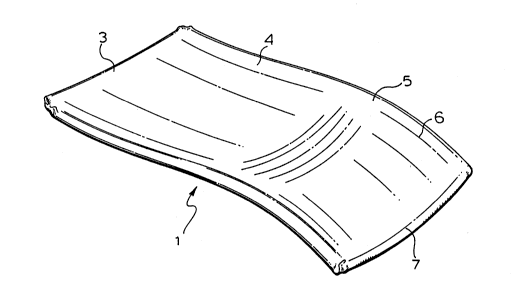Some of the information on this Web page has been provided by external sources. The Government of Canada is not responsible for the accuracy, reliability or currency of the information supplied by external sources. Users wishing to rely upon this information should consult directly with the source of the information. Content provided by external sources is not subject to official languages, privacy and accessibility requirements.
Any discrepancies in the text and image of the Claims and Abstract are due to differing posting times. Text of the Claims and Abstract are posted:
| (12) Patent: | (11) CA 2054992 |
|---|---|
| (54) English Title: | POSTURE BOARD |
| (54) French Title: | PLANCHE POSTURALE |
| Status: | Expired |
| (51) International Patent Classification (IPC): |
|
|---|---|
| (72) Inventors : |
|
| (73) Owners : |
|
| (71) Applicants : |
|
| (74) Agent: | DENNISON ASSOCIATES |
| (74) Associate agent: | |
| (45) Issued: | 1997-01-14 |
| (22) Filed Date: | 1991-11-05 |
| (41) Open to Public Inspection: | 1993-05-06 |
| Examination requested: | 1993-06-08 |
| Availability of licence: | N/A |
| (25) Language of filing: | English |
| Patent Cooperation Treaty (PCT): | No |
|---|
| (30) Application Priority Data: | None |
|---|
The posture board according to the present
invention is contoured to a spinal mating shape. The board
comprises an upper back supporting portion having a leading
edge and a lower back supporting portion terminating in a
trailing edge. The board has a longitudinally extending
sine wave configuration with an up curve at the lower back
supporting portion. The board further has a side to side
concave curvature defining a trough like center region and
upwardly turned outside edges. The center region along at
least part of the upper back supporting portion and at the
trailing edge is in contact with the supporting surface on
which the posture board is used. The up curve defines a gap
beneath the center region along the lower back supporting
portion and the supporting surface. The outside edges of
the board are more flexible than the center region to allow
some edge flattening while the center region is much less
flexible to prevent lengthwise full flattening of the board
at the center region under weight of a user such that the
board provides vibratory feedback responsive to body
vibrations given off by the user.
Note: Claims are shown in the official language in which they were submitted.
Note: Descriptions are shown in the official language in which they were submitted.

For a clearer understanding of the status of the application/patent presented on this page, the site Disclaimer , as well as the definitions for Patent , Administrative Status , Maintenance Fee and Payment History should be consulted.
| Title | Date |
|---|---|
| Forecasted Issue Date | 1997-01-14 |
| (22) Filed | 1991-11-05 |
| (41) Open to Public Inspection | 1993-05-06 |
| Examination Requested | 1993-06-08 |
| (45) Issued | 1997-01-14 |
| Expired | 2011-11-05 |
There is no abandonment history.
| Fee Type | Anniversary Year | Due Date | Amount Paid | Paid Date |
|---|---|---|---|---|
| Application Fee | $0.00 | 1991-11-05 | ||
| Maintenance Fee - Application - New Act | 2 | 1993-11-05 | $50.00 | 1993-11-05 |
| Maintenance Fee - Application - New Act | 3 | 1994-11-07 | $50.00 | 1994-10-26 |
| Maintenance Fee - Application - New Act | 4 | 1995-11-06 | $50.00 | 1995-11-02 |
| Maintenance Fee - Application - New Act | 5 | 1996-11-05 | $75.00 | 1996-11-05 |
| Maintenance Fee - Patent - New Act | 6 | 1997-11-05 | $75.00 | 1997-11-05 |
| Maintenance Fee - Patent - New Act | 7 | 1998-11-05 | $75.00 | 1998-10-30 |
| Maintenance Fee - Patent - New Act | 8 | 1999-11-05 | $75.00 | 1999-10-11 |
| Maintenance Fee - Patent - New Act | 9 | 2000-11-06 | $75.00 | 2000-11-03 |
| Maintenance Fee - Patent - New Act | 10 | 2001-11-05 | $100.00 | 2001-11-05 |
| Maintenance Fee - Patent - New Act | 11 | 2002-11-05 | $100.00 | 2002-10-02 |
| Maintenance Fee - Patent - New Act | 12 | 2003-11-05 | $100.00 | 2003-11-04 |
| Maintenance Fee - Patent - New Act | 13 | 2004-11-05 | $125.00 | 2004-10-29 |
| Maintenance Fee - Patent - New Act | 14 | 2005-11-07 | $125.00 | 2005-11-01 |
| Maintenance Fee - Patent - New Act | 15 | 2006-11-06 | $225.00 | 2006-11-01 |
| Maintenance Fee - Patent - New Act | 16 | 2007-11-05 | $225.00 | 2007-10-30 |
| Maintenance Fee - Patent - New Act | 17 | 2008-11-05 | $225.00 | 2008-10-29 |
| Maintenance Fee - Patent - New Act | 18 | 2009-11-05 | $225.00 | 2009-10-30 |
| Maintenance Fee - Patent - New Act | 19 | 2010-11-05 | $225.00 | 2010-11-04 |
Note: Records showing the ownership history in alphabetical order.
| Current Owners on Record |
|---|
| SHIELDS, MARY |
| Past Owners on Record |
|---|
| None |